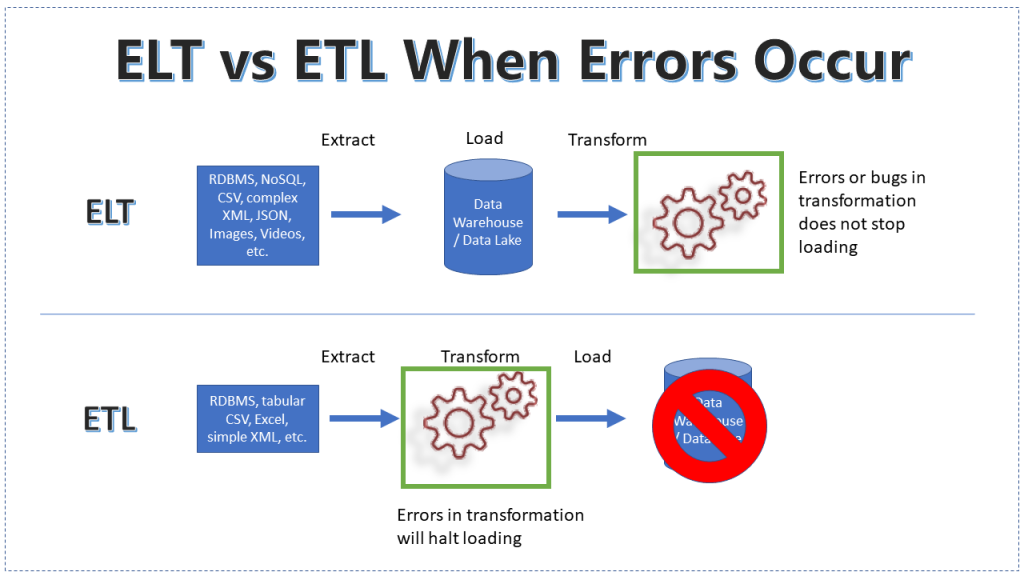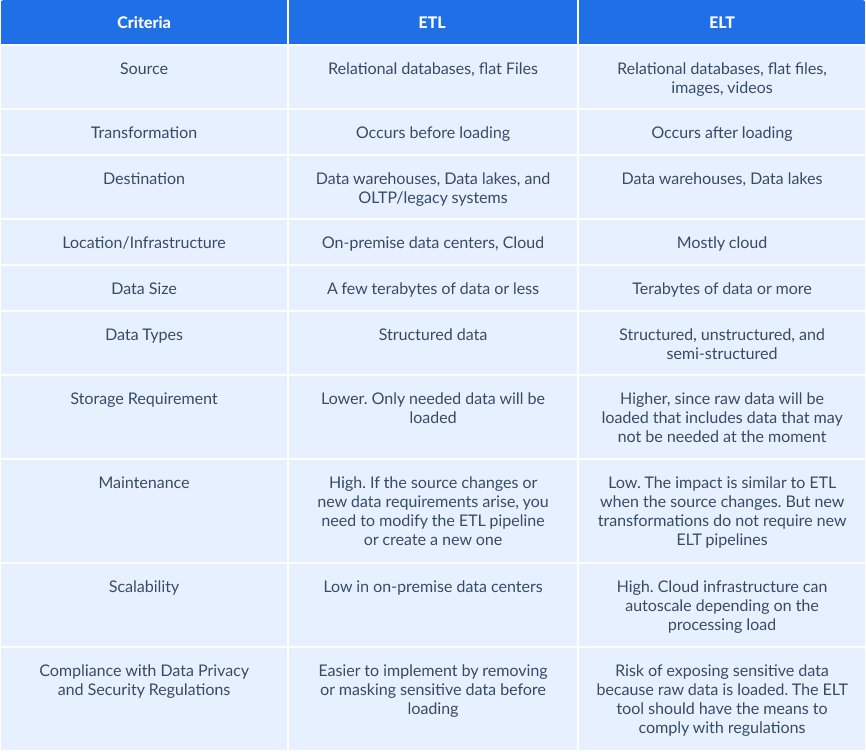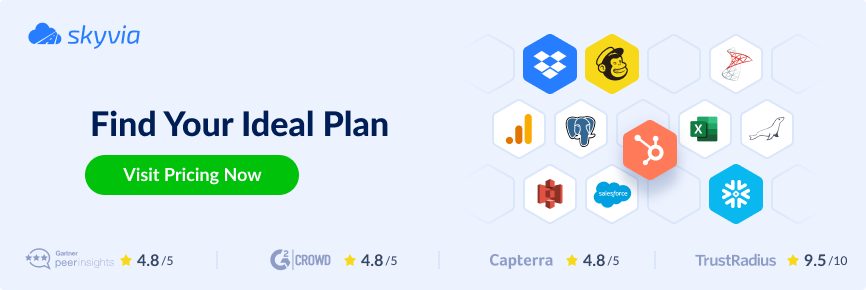ELT vs ETL – The difference in the acronym is so minute. It can cause a typo. And yet, both ETL and ELT processes are important in today’s data processing. So, if you’re looking for their stark differences, you’re in the right place.
Maybe you heard that ETL is much more mature. But ELT is the newer kid on the block. So, is it ETL or ELT? If you’re confused, you’re not alone. That’s why this article will discuss the differences, the pros and cons, and the use cases of these two data pipelines.
Table of contents
- What Is ETL?
- What Is ELT?
- Key Differences Between ETL and ELT Processing
- ETL vs ELT Comparison Table
- Advantages and Disadvantages of ETL
- When is Better to Use ETL Instead of ELT?
- When is Better to Use ELT over ETL?
- Summary
- Cloud ETL and ELT Solutions
Let’s start the comparison by introducing each of them. Let’s begin.
What is ETL (Extract, Transform, Load)?
So, what is ETL? ETL stands for Extract, Transform, Load. Let’s extend the ETL meaning further. It is a data pipeline that copies data from various data sources. Then, this copy is transformed by cleansing, summarizing, filtering, and more. And finally, the transformed data is loaded to a target database.
There are a few ways ETL can behave too. It can be by batch by updating chunks of data on a regular schedule. Batching can be full load or incremental load. ETL can also be streamed. Streaming ETL or real-time ETL is a way to copy source data to a target when a minute of processing is too long. And last is Reverse ETL, where the source and targets are reversed. Instead of the data warehouse being the target, it becomes the source. Then, after some transformations, insights are copied back to operational systems.
It is an ETL data pipeline, but of course, reversed. Instead of having the data warehouse as the target, it becomes the source. And the insights coming from it will be formatted and pushed to the target third-party apps. Figure 1 below illustrates that point.
ETL is in use since the ’70s for data warehousing. So, it’s already a traditional method or pattern in processing data. It’s also mature to the point that various ETL tools exist, and a lot of people with data pipeline skills know it.
ETL Use Cases
What is ETL used for?
Here are some of the common ETL use cases:
- Combine data from different sources. One scenario is using the same legacy system from 2 remote locations. ETL can merge the data of the 2 locations. Another scenario is combining the data of 2 merging companies into one.
- Integrating one system to another. From experience, I made an SSIS ETL pipeline to integrate 2 systems. The first is a petty cash system done in SharePoint. And the other is SAP Financials used by accountants. Both are on-premise. Every day, petty cash transactions are read and transformed until it reaches the accounting books.
- Data import/export. One example is when an Accounting staff wants to extract or export invoice data to a CSV file. Or read the data from a biometrics machine, format it, and load it to a SQL Server database.
In a later section, you will learn more about when to use ETL.
What is ELT (Extract, Load, Transform)?
So, what is ELT? ELT stands for Extract, Load, Transform. Let’s extend the ELT meaning further. ELT data pipeline works by copying the data source to the destination. And then, the destination’s computing power will handle the transformations.
While ELT history shows it has recently gained popularity, the concept is not new. With the wider adoption of the cloud and data lakes, ELT adoption also accelerated. It makes sense because of these factors: the growing data size, cheaper cloud storage, and faster internet.
When we talk about ELT, we generally mean cloud-driven ELT. Well-known ELT tools harness the power of the cloud. ELT is the answer to an ever-increasing size of data where gigabytes are too small. To make this work, the autoscaling cloud infrastructure and near-infinite storage are necessary. So, this scenario will only make sense in the cloud.
ELT Use Cases
So, why use ELT?
Here are some ELT use cases:
- Performing ML algorithms on thousands of images stored in a data lake from security cameras.
- Data mining a NoSQL data for consumer behavior, product sentiment, or purchasing patterns.
- Collecting and analyzing a huge volume of meteorological data from weather stations.
Note that some use-cases in ELT can also be done using ETL. One example is data warehousing. And note that both ELT and ETL can also work with structured data. The difference is in the approach used.
In a later section, you will learn more about when to use ELT.
Key Differences Between ETL and ELT Processes
Let’s explain the ELT vs ETL key differences further.
The main difference between ETL and ELT processes lies in the transformation. With this, the difference is like night and day between ELT and ETL workflows. This is shown in the figure below.

It illustrates the ETL meaning we had earlier. Meanwhile, ELT delays the transformation until everything is loaded to the destination. This difference affects the pipeline’s maintainability, data security, and compliance.
Because of ETL’s approach, errors during transformation will stop the loading to the destination. This doesn’t happen in ELT, as shown in the figure below.

Moreover, fixing the ETL pipeline for bugs requires restarting the whole ETL pipeline. So, the transformed data will reach the destination.
Another key difference between ELT and ETL lies in the data it can process. Notice in Figure 1 that ELT sources can also be unstructured like images and videos. ETL only allows structured data. The size of these data is a differentiating factor too. ELT can handle big data when ETL performs badly with it.
Finally, another key difference is where the pipeline lives. ETL pipelines can either be on-premise or in the cloud. Meanwhile, ELT pipelines are mostly cloud-based.
ELT vs ETL Comparison Table
Below is the ETL and ELT comparison table.

Advantages and Disadvantages of ETL
From here, let’s examine the ETL and ELT pros and cons.
Let’s start with ETL.
ETL Advantages
- Data in the ETL destinations are cleaner. Duplicates and orphaned records are removed before reaching the destination.
- Compliance with GDPR, HIPAA, and others is easier with ETL.
- This method of data integration and processing is mature.
- The data warehouse or data lake that used ETL requires less storage.
ETL Disadvantages
- ETL is less flexible. New data requirements not in the data warehouse will require another ETL pipeline.
- And because it’s less flexible, new requirements can be slower to implement compared to ELT.
- Then, ETL pipeline maintenance is also higher.
- The need to transform first before loading slows the loading process. And errors will prevent loading too.
When is Better to Use ETL Instead of ELT?
Though ETL has its drawbacks, there’s a place for it in your data integration efforts. So, when can you opt for ETL as the better option?
The following are the common reasons when ETL should be used:
- Batch processing is enough for your requirements when data volume is not that much. Do you have 0-10 transactions per day? If you sell products like sports cars, luxury real estate, expensive yachts, or the like, you can opt for a batch ETL. They won’t sell a million items per week for all eternity anyway.
- When you need to integrate 2 or more legacy systems on-premise. Does your organization use fingerprint readers? And do you import the records from it for attendance and payroll purposes? Is your Human Resource and Payroll system a legacy, on-premise system? Then, ETL is the obvious choice.
- Integrating one or more Software as a Service cloud solutions for further analysis. If your volume is not that much for each of the cloud solutions, a cloud ETL tool is your best buddy to help you.
Pros and Cons of ELT
Now, let’s check out the ELT camp. Here are the ELT pros and cons.
Pros
- Faster time to value. If you have several analytic reports in mind and want them realized quickly, ELT is your best bet. Why? See the next item.
- ELT is more flexible. You can extract and load your raw data and do transformations on demand. This speeds up the development iterations of your analytical reports. Plus, you also have flexible types of data that includes unstructured and semi-structured data.
- Process massive growth with faster results.
- ELT requires minimal maintenance.
Cons
- The destination is messy since transformation occurs last. Data reaches the destination as is — with duplicates and orphaned records.
- Risk of low to non-compliance with data protection and privacy laws.
- Storing raw data in the destination requires more cloud storage.
- ELT is a newer approach so the number of tools and experts in this field is still growing.
When is Better to Use ELT over ETL?
So, when to use ELT?
ELT should be used when:
- you need to process enormous amounts of data, like petabytes or more. And then store it fast in cloud storage.
- you foresee massive growth of data and ETL’s speed is no longer tolerable.
- your eyeing a cloud ELT tool and your organization is cloud-ready.
- your stakeholders are in a hurry for analytics. ELT can be faster to deliver than traditional ETL pipelines. And it’s also flexible to adapt to their changing minds.
- you need to do machine learning on an enormous load of unstructured data.
Summary
Have you decided yet on ELT vs ETL?
Both ETL and ELT are important in today’s data-driven organizations. You may want to use both depending on the need.
Remember: ELT is for faster loading and on-demand transformation. It deals mostly with big data that is structured, unstructured, or semi-structured on the cloud. ETL is for a few terabytes or less of structured data that can be batch or real-time. ETL is also for on-premise, legacy data.
Cloud ETL and ELT Solutions
There is a number of cloud tools, supporting ELT or ETL scenarios. Here are some of the examples:
ETL Tools
- XPlenty — a cloud ETL tool for easy-to-use data integration.
- Informatica PowerCenter — an enterprise-grade data integration platform.
- Stitch — a cloud-based ETL platform that can be used to integrate with different data sources.
- Dataddo — a no-code, cloud-based ETL platform for flexible data integration.
ELT Tools
- Fivetran — a cloud ELT tool for building reliable data pipelines.
- Airbyte — an ELT tool with an open-source and cloud version.
- Blendo — a well-known ELT tool for centralizing different data sets into one location.
- Matillion — an ELT tool to load data into cloud data warehouses.
Skyvia
Skyvia is a powerful data platform that offers both ELT and ETL tools. For ELT scenarios it offers Replication tool which allows copying cloud data to cloud and on-premise databases and data warehouses with little to no configuration efforts. You only need to create connections to corresponding data sources, select what data to replicate, and then schedule replication for automatic execution. Everything can be done in under 5 minutes.
ETL use cases, Skyvia offers multiple tools. Import allows loading data from one source to one destination while using powerful mapping settings for transformations. These mapping sessions include lookups, expressions with a number of supported mathematical, string, datetime functions, etc. For more complex ETL scenarios, including multistage transformations, extracting data from various sources and loading them into multiple destinations, you can use Data Flow. It is a designer-based tool, where you create your data pipeline on a diagram by adding and connecting different components.
Did you find this article helpful? Then please share it with your friends and followers on your favorite social media platforms.

